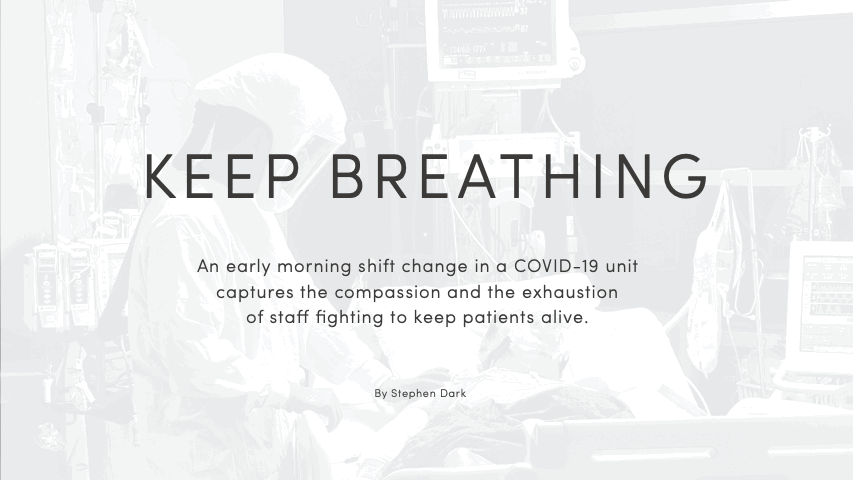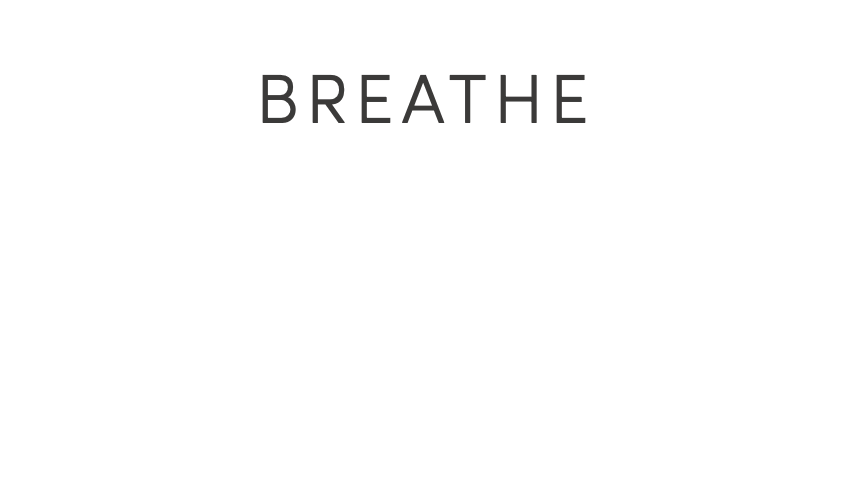
Nothing prepared them for the onslaught of ever-climbing numbers of patients succumbing to COVID-19’s cruel, suffocating ravages. And December 10, 2020 was no different. Towards the end of the night shift, a patient died from COVID-19. Shortly after the day shift took over patient care at 7 am, another patient would die in the 25-bed unit.
In a world of masks, eyes tell all: tiredness, exhaustion, and the same question day after day—will this ever end?
That Thursday morning, nearly all the patient rooms had red signs hanging above their doors, declaring the virus’ presence.
The central monitor at the nurse’s station offered a constant snapshot of the medical story of the unit’s patients, their heart rate, respiratory rate, blood pressure, and oxygen level. When a patient’s situation took a turn for the worse, a nurse crouched in front of the monitor, hand on the mouse, closely analyzing the data before running to the patient’s room.
The nurse’s station is where a frontline worker can catch their breath for a moment—powered air purifying respirator (PAPR) still over their shoulder—and try to process yet another startling, COVID-19 related event that has just taken place in a patient’s room. “Guys, guess what just happened."
This is what the unit calls the family table. It’s where staff gather, when patient care permits, to catch up, touch base, shoot the breeze.
It’s where the night or day shift can take stock for a few minutes as they wind down until the next shift comes on, grateful to have made it through another 12-hour stint.
When COVID-19 patients’ breathing
deteriorates to the point they have to be put on a ventilator, one concern is to try to get oxygen to all areas of the lungs. That requires proning, a physically and mentally demanding, time-consuming process for nurses. That's because they have to work together in a series of synchronized movements to turn a patient onto their stomach, so oxygen can reach the back of their lungs. Sixteen hours later, they turn the patient back over. Eight hours more and they flip them over again on their stomach. And on it goes.
Proning means all hands on deck, twice a day. It’s exhausting work.
So much can potentially go wrong—a breathing tube becoming dislodged, a patient’s blood pressure collapsing, cardiac arrest. As the number of COVID-19 patients in the unit during the winter weeks and months grew, so inevitably did the number of patients needing proning.
COVID-19 patients have a very hard time breathing. It’s not only the virus’ impact on their lungs. They can experience anxiety to the point of not remembering to breathe due to a variety of factors: knowing they are COVID-19 positive and the implications of that diagnosis; being in such a foreign environment as an ICU, isolated from loved ones with only providers in space suits for company. Then there’s the machinery they are hooked up to. While a C-PAP machine can help them breathe, it’s tightly affixed to their face. Not only is it humid, it’s also claustrophobic.
It’s just a hand on a shoulder and a few soothing, gentle words, as a respiratory therapist urges the patient to do something that ultimately their life depends on.

PAPRs have to be cleaned before a frontline worker can go into a patient’s room and then cleaned again after they exit.
After staff have donned their PAPRs and gone into the patient room, it’s only then they realize that having gone through all the long-since secondhand protocol, they have forgotten something as simple as a syringe. So the staff member sticks her head out the door to ask for help. Sometimes it’s so busy, there‘s no one to be seen. Everybody is in a room dealing with their own patients' medical crises.
Mostly though, someone can usually answer a call for help, respond to a question, or bring the needed supply. The charge nurse will check in on their nurses and the patient, tapping on the window to ask for a sign—thumbs up, thumbs horizontal, or thumbs down.
Nurses have to be able to multi-task: cleaning their PAPR while talking to a colleague and also moving to another room. It never stops for 12 hours. Sometimes they get to the end of the shift and haven’t eaten or even gone to the bathroom.
Until finally, at shift end, it’s time for the safety briefing. The off-going charge nurse reviews for oncoming workers the unit’s patients, giving the bigger picture of what’s going on. As the new shift preps for work, hustling and rustling, he or she is the voice of authority: clear, precise, and focused.
Each nurse chooses typically two patients for their shift. There’s an expectation that new nurses pick first, then those nurses who are orienting others. Then comes those who haven’t had an opportunity to work with a certain type of machine or procedure before.
Sometimes the litany of near-death patients can be overwhelming as they look down the list of COVID after COVID after COVID patients and listen to the charge nurse work his or her way down the list.
This patient isn’t getting better. We need to withdraw care on this patient. Someone should discuss end-of-life goals with this patient‘s family. This patient is actively dying. This patient is waiting for family to say goodbye. If nurses were on shift the day before, they usually ask for the same patients again, so there's continuity of care.f
Health care assistants are another pair of hands to prone, turn, bathe and move patients, collecting blood sugar, grabbing supplies and being a second pair of eyes on challenging patients. In sum, they help out however they can. Along with the Environmental Services technicians who clean the rooms, they are a fundamental resource for the unit.
Notes from people in the community saying thank you are plastered all over the unit. They are reminders that people do care about what frontline workers are going through, even if they feel so cut off from the rest of the world at times. Equally if not more impactful are letters and emails from virus survivors and relatives of deceased patients sharing their perspective on what they went through at the unit.
Much like charge nurses and nurse managers, attending physicians set the unit’s tone.
They have final say on which patients are admitted to the unit, the treatments they receive, which patients are sufficiently stable to leave the ICU and when it's time to discuss end of life care with a patient's relatives. In the event that a patient is alone in the world, then the attending can make the decision for withdrawal of care, although a second attending has to sign off on it.
Come rounds, as the attending moves around the unit with staff in tow, reviewing each patient's case, she or he signs off on the plan residents and others present to them.
There’s a line the unit holds—between clean and dirty, infectious and non-infectious. Nurses in PAPRs care for a patient while others stand poised outside, ready to run in and help at a moment' s notice.
At the heart of each and every 12-hour shift: unbidden acts of compassion.
Hooked up to so many machines, the patient is naked, flipped on their belly, their very humanity in so many senses all but denied. A nurse takes a moment to simply connect with a patient. He touches their back with his plastic-gloved hand, conveying—whether they can feel it through the fog of drugs or not—an essential message.
You are human
and I’m going to care for your body and
your soul.
You are human
and I’m going to care for your body and
your soul.
KEEP BREATHING
February 4, 2021
Story by Stephen Dark
Photography by Bryan Jones
Design by Stace Hasegawa
Thank you to charge nurse Christy Mulder for her help with this project.
KEEP BREATHING
February 4, 2021
Story by Stephen Dark
Photography by Bryan Jones
Design by Stace Hasegawa
Thank you to charge nurse Christy Mulder for her help with this project.
